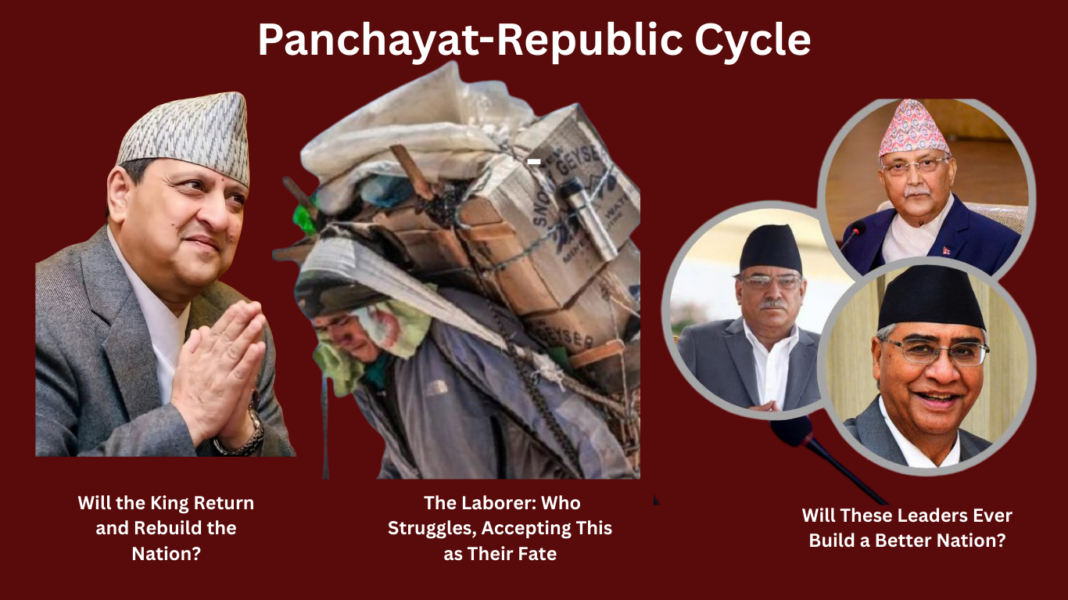Nepal has a long and tumultuous history of political transformation. From the Panchayat era to the establishment of a republic, Nepalis have witnessed, endured, and suffered through various forms of governance. Yet, the fundamental question remains unanswered—when will Nepal and its people truly experience prosperity and progress?
The Panchayat Era: Restricted Democracy and Repression
In 1960, King Mahendra dissolved the democratic system and imposed the party-less Panchayat system, shutting the doors to political freedom in Nepal. During this period, pro-democracy leaders, both from the Nepali Congress and the Communist Party, operated movements from exile in Banaras, India, with a singular goal: to overthrow the Panchayat system and restore multiparty democracy.
However, those who criticized the Panchayat system were labeled as “reactionary elements” or pratigami tatwa. This term was used by royalists and supporters of the Panchayat regime to denounce pro-democracy forces, including the Nepali Congress, communists, and other democratic activists who sought to dismantle the autocratic regime. The royalists believed that these opposition groups were a threat to national unity, stability, and the traditional values supported by the Panchayat system—such as monarchy, Hinduism, and Nepali nationalism.
Mandale vs. Reactionaries: A Battle of Ideologies
On the other hand, the opponents of the Panchayat regime derogatorily referred to the royalists and their supporters as mandale. This term, derived from the historical term “Nepal Mandal,” which referred to the Kathmandu Valley, was used pejoratively to describe the loyalists of the monarchy. The term mandale painted the royalists as an elite, valley-centric group disconnected from the larger population, benefiting from the king’s protection while living off the resources of the nation.
These terms encapsulated the deep ideological rift of the time—where the royalists saw the opposition as dangerous disruptors, and the opposition viewed the royalists as oppressive and regressive. This war of words was part of the larger struggle that culminated in the People’s Movement of 1990 (Jana Andolan I), which ultimately dismantled the Panchayat system and restored multiparty democracy.
The 1990 People’s Movement and the Return of Multiparty Democracy
The 1990 People’s Movement brought an end to the Panchayat system, paving the way for the restoration of multiparty democracy. However, the anticipated change did not materialize. Governments changed frequently, but the lives of ordinary Nepalis remained the same. Political instability, corruption, and self-serving leaders tarnished the image of democracy.
The Maoist Insurgency and the Establishment of a Republic
In 1996, the Maoists launched a decade-long armed insurgency, also known as the “People’s War,” which ultimately led to the abolition of the monarchy and the establishment of a federal democratic republic in 2008. However, despite the end of the monarchy and the adoption of a republican system, the dreams of prosperity and progress for the people remained unfulfilled.
Post-Republic Era: 13 Governments, But No Change
Since the declaration of the republic, Nepal has witnessed 13 different governments. Yet, no significant progress has been made in improving the lives of the people. While politicians and their families accumulated wealth and power, ordinary Nepalis were forced to migrate to Gulf countries in search of employment. Democracy became a tool for the elite, while the promises of change remained a distant dream for the masses.
The Revival of Monarchist Sentiments: ‘Bring Back the King, Save the Nation’ Movement
In the midst of ongoing political instability, corruption, and poor governance, royalist sentiments are once again on the rise. Former King Gyanendra’s appeal for support has reignited the “Bring Back the King, Save the Nation” campaign, leading to widespread demonstrations in Kathmandu and other parts of the country. The streets of the capital have echoed with the same old slogans—while the government dismisses the movement as a gathering of mandale, and the protestors call the ruling party supporters pratigami tatwa.
What Now? When Will True Change Arrive?
Nepal has witnessed the Panchayat regime, multiparty democracy, and republican governance. Yet, the aspirations of the people remain unfulfilled. Despite the sacrifices of 17,000 lives during the Maoist insurgency, the nation has yet to witness tangible progress. Governance systems have changed, but the fate of the people has remained the same.
The critical question now is: Which system will truly uplift Nepal and its people? When will Nepalis see the dreams of progress and prosperity materialize? It is time for leaders to shift their focus from power struggles to addressing the aspirations of the people. Whatever system comes—unless it is committed to the well-being of the people—Nepal’s progress will remain a distant dream. When will the day come when Nepalis can finally witness the dawn of prosperity and a better future?
Freelance Writer




